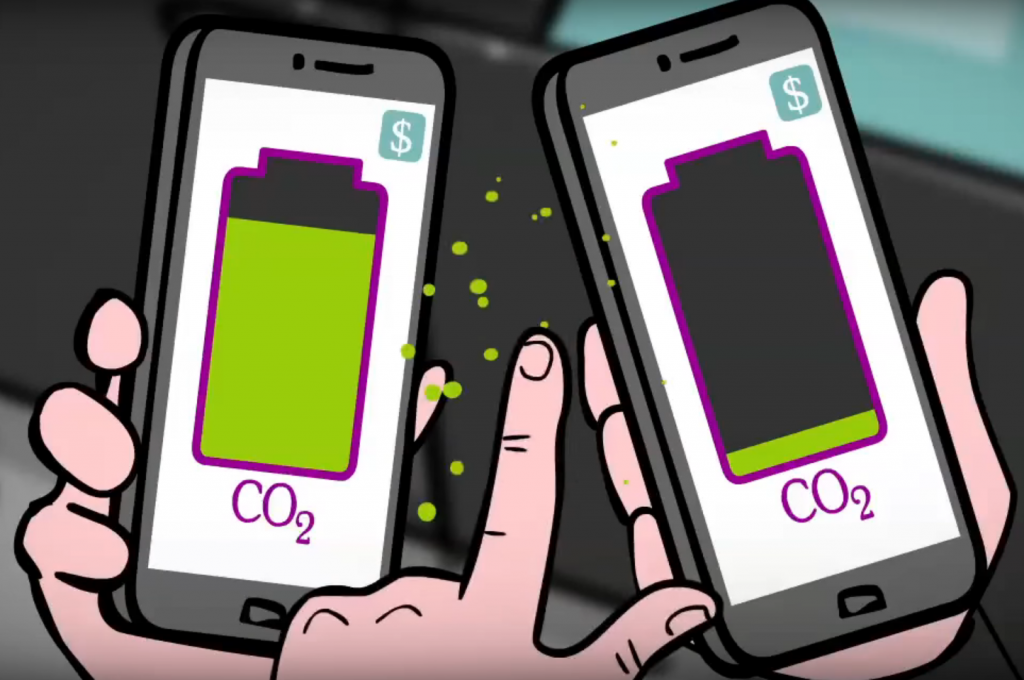Updated on 2024-09-22 by Adam Hardy
Faced with ever more obvious signs of damaging climate change all around the world, a clear and effective way to reduce CO2 emissions and keep atmospheric warming to a minimum must be every government’s goal. EcoCore advocates that every individual receives an equal carbon allowance, consisting of carbon tokens which represent a certain amount of CO2 emissions. The policy we are working on envisages a carbon account for every financial entity, person, business or public entity to manage their carbon tokens, and this results in production limits for the fossil fuel producers.
The carbon allowance is distributed fairly to every citizen on a regular basis. As people spend the carbon tokens from their allowance, they flow through the economy like money, so there are dual transactions involved for all goods and services – one in cash and one in carbon.[1]For the complete explanation of the framework, see the proposal here
The carbon account mechanism would need a major initial ramp-up costs in terms of time and money, but once underway offers significant advantages over other climate solutions that pay a high price for their convenience, principally the significant risk that they just won’t be adequate or fast enough in cutting emissions.
Key Features of Carbon Accounts
- Fair shares for all – the beauty of the allowance mechanism is that it’s per capita, so chief executives and office cleaners, royalty and the unemployed, all receive the same quota. It offers an economic policy with real advantages and voting appeal in terms of employment, welfare and social equality.
- Freedom of choice – No one dictates how you use your tokens. People make their own choices and will soon learn to be as canny about carbon use as they are about their money. Just as you are free to spend your allowance on holidays, clothes or charities, you can also sell it or buy more. Another voter winner.
- Personal carbon trading – this benefits those who have no need of or desire for a high-carbon lifestyle and sets up a flow of funds from the rich to the poor, rewarding and providing the equivalent to a Universal Basic Income, allowing the worst affected by climate impacts to afford to take countermeasures. It creates a huge incentive to find low carbon options first.
- Real-time carbon labelling – Every kind of good or service is priced in the carbon tokens according to the total cost to the seller, supplier, wholesaler or retailer in terms of emissions. The carbon price starts with the initial carbon cost of energy production at the beginning of the supply chain and accumulates at each step in the supply chain, as each business in the chain adds their carbon costs. A product’s carbon price will always be right up-to-date, including packaging, freight, and storage. It results in a dynamic, responsive, unique carbon price for everything – no official government database required.
- Competitive advantage – having a lower carbon price will make goods more attractive to buyers. Unlike all other carbon pricing systems, a carbon currency will create a price that isn’t combined with the cash price. In a large proportion of situations, raising something’s cash price to adjust for CO2 emissions just has no impact as other factors in the cash price are actually more decisive. The real carbon price of everything on a dual price label – throughout business supply chains as well as retail – will result in a huge commercial push to reduce emissions with rapid innovation and disruption in business practice.
- Inclusive yet simple – this comprehensive system should be more impactful than any piecemeal legislation, carbon taxes, emissions trading schemes or pricing policies. Even contentious sectors like aviation, shipping, inbuilt or imported emissions, as well as every government service, will be required to pay in carbon tokens as well as money. With an all-inclusive approach, any significant loopholes or exclusions will be transparent to all.
- Equitable payment for carbon drawdown – the government will use carbon tokens from the national carbon budget to pay for the removal of carbon dioxide from the atmosphere. This allows schemes such as tree planting, reforestation, restoring peat bogs, or mechanical CO2 sequestration to be funded in carbon tokens from the single national authority, circumventing the argument of who has to pay for CO2 removal. We all pay. For example, the government would pay in carbon tokens for the sequestration of carbon in soils via sustainable farming practices or rewilding, the protection of ocean carbon sinks, or the mechanical drawdown and sequestration of CO2.
- One regulatory body – a carbon drawdown payments facility establishes a single point of governance, a clear path to financing projects, improving regulation and governance of today’s over-complex and sometimes questionable carbon offsetting industry, emissions trading schemes and voluntary carbon markets.
- Hands-on control of fossil fuel production limits – government-issued carbon tokens flow from consumers through the supply chain to the original producer of the fossil fuels, directly controlling the amount of fossil fuels produced by the oil, gas and coal industry. The fossil fuel producers must surrender a carbon token worth 1 kilo to the government for every 1 kilo of fossil fuel they extract from the ground.
- Complements energy efficiency measures – the Jevons Paradox[2]In economics, the Jevons paradox (/ˈdʒɛvənz/; sometimes Jevons effect) occurs when technological progress or government policy increases the efficiency with which a resource is used (reducing the … Continue reading is a law of economics which describes how the efficiency measures lead to more consumption as opposed to savings. So people hoping that energy efficiency measures will bring down CO2 emissions would be disappointed, because consumption of energy would just increase as people use the savings to do more. Everybody’s carbon accounts will prevent increased use of fossil fuels, driving any new demand towards other clean energy sources.
- Market-based mechanism facilitates cross-border trade – since carbon tokens will be designated in tonnes and kilos of carbon released as CO2, the system sets a standard that can be easily integrated across industries and trade borders.
- Popularity – surveys in a number of industrialised countries show that the public finds per capita quota-based systems such this to be fair and desirable, so are likely to support such a policy, especially if the introduction is well managed and only the most profligate carbon emitters are impacted at the start.
- Covering all the bases – carbon accounts can cover methane and other greenhouse gases via licences priced in carbon tokens. So for example, a dairy farmer will need to purchase a licence for each of his cows, paid for in carbon tokens, the amount being dependent on the amount of methane emissions in his particular farming system, or a cement manufacturer can obtain a license paid for in carbon tokens to produce cement with a price dependent on the quantity of emissions produced.
Of course there are no quick fixes. But the carbon accounts mechanism brings a catalogue of benefits. When business-as-usual finally succumbs to reality, this option must be ready and waiting. EcoCore is a community interest company, funded by donations – if you want to help, please become a patron with a small regular donation here via Patreon
![]() .
.
More about Carbon Allowances

On the page “Carbon allowances as a carbon currency” you can find the outline of the whole proposal with references to relevant articles and websites.

The Global Commons Institute’s Contraction and Convergence policy can be used to integrate nations adopting the carbon accounts approach. Here’s a run-down of the world’s most elegant climate policy.
The carbon accounts mechanism is a combination of several climate policies:
- Personal Carbon Trading (see Dr Tina Fawcett of Oxford University ECI – one of the academics who gave feedback on and endorsed this project)
- “How to Save the Planet” by Mayer Hillman and Tina Fawcett which outlines the need and the functionality for personal carbon credits or allowances
- Universal Basic Income – in a future beset by economic upheaval from calamitous climate change and further pandemics, UBI is likely to prove very effective in ameliorating the impacts on the population.
- Œconomie – the French philosophical work[3]English translation: https://hidrive.ionos.com/lnk/JrKAYiUJ#file on economics points to the irrationality behind society’s obsession with a single currency as the sole arbiter of value in the economy. Œconomie is the origin of the word economy, from the Greek oikos meaning household and nomoi meaning management, to which we should return if we want a holistic approach to managing the economy.
- Tradable Energy Quotas – TEQs – “Energy and the Common Purpose: Descending the Energy Staircase with Tradable Energy Quotas” by David Fleming
- The Global Carbon Reward – a carbon pricing policy to allow nation states to fund CO2 emissions reduction, drawdown and sequestration via monetary policy
Personal Carbon Trading or PCT is a mechanism for increasing flexibility and efficiency in a carbon allowance or cap-and-trade scheme. It is a component in our policy for a carbon…
References
| ↑1 | For the complete explanation of the framework, see the proposal here |
|---|---|
| ↑2 | In economics, the Jevons paradox (/ˈdʒɛvənz/; sometimes Jevons effect) occurs when technological progress or government policy increases the efficiency with which a resource is used (reducing the amount necessary for any one use), but the falling cost of use increases its demand, increasing, rather than reducing, resource use. |
| ↑3 | English translation: https://hidrive.ionos.com/lnk/JrKAYiUJ#file |




